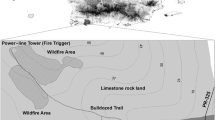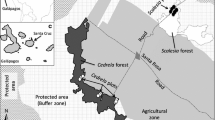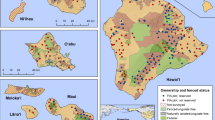Abstract
Gorse (Ulex europaeus L., Fabaceae) is an invasive species of worldwide concern. However, knowledge of its effects on ecosystem and community structure is still missing from most areas of its invasive range, including species-rich ecosystems such as the forest–grassland mosaics of southern Brazil. We studied the influence of landscape mosaic structure and land use on gorse distribution. At the community scale, we examined the effects of proximate gorse canopies on plant community abundance, diversity, and composition. Vulnerability to gorse invasions was highest in heavily grazed grasslands, where gorse canopy cover often reached 50 %. Gorse did not invade natural forests. However, gorse invaded tree plantations. Gorse cover in relatively undisturbed areas, such as ungrazed natural grasslands, was found to be variable, although the physiognomy and structure of mosaic ecosystems was still affected. Gorse canopies exerted significant effects on community structure and composition. Assemblages in the understory of gorse canopies were comparatively species-poor and more homogeneous than beside gorse canopies. Woody species were more abundant in the understory of gorse canopies than in areas beside gorse canopies, whereas the cover of grasses decreased under gorse canopies. We argue that invasions can differentially affect the components of natural forest–grassland mosaics, which could have long-term consequences. Selecting competitive species for restoring native assemblages can provide successful outcomes in managing risks associated to invasive species like gorse.






Similar content being viewed by others
References
Atlan A, Barat M, Legionnet AS, Parize L, Tarayre M (2010) Genetic variation in flowering and avoidance of seed predation in native populations of Ulex europaeus. J Evol Biol 23:362–371
Baldi G, Paruelo JM (2008) Land-use and land cover dynamics in South American temperate grasslands. Ecol Soc 13:6–22
Baldi G, Guerschman JP, Paruelo JM (2006) Characterizing fragmentation in temperate South America grasslands. Agric Ecosyst Environ 116:197–208
Barbosa CEA, Benato T, Cavalheiro AL, Torezan JMD (2009) Diversity of regenerating plants in reforestations with Araucaria angustifolia (Bertol.) O. Kuntze of 12, 22, 35, and 43 years of age in Paraná State, Brazil. Restor Ecol 17:60–67
Baselga A, Orme D, Villeger S, de Bortoli J, Leprieur F (2013) Partitioning beta diversity into turnover and nestedness components. R Package Version 1.3. https://cran.r-project.org/web/packages/betapart/betapart.pdf. Accessed 13 Aug 2015
Bergamín RS, Müller S, Mello R (2012) Indicator species and floristic patterns in different forest formations in southern Atlantic rainforests of Brazil. Community Ecol 13:162–170
Bergin DO, Kimberley MO (2014) Factors influencing natural regeneration of totara (Podocarpus totara D. Don) on grazed hill country grassland in Northland, New Zealand. N Z J For Sci 44:13
BFG (2015) Growing knowledge: an overview of seed plant diversity in Brazil. Rodriguésia 66(4):1085–1113
Biddinger DJ, Weber DC, Hull LA (2009) Coccinellidae as predators of mites: Stethorini in biological control. Biol Control 51:268–283
Binggeli P, Hall JB, Healey JR (1998) An overview of invasive woody plants in the tropics. University of Wales, School of Agriculture and for Sciences [Publication no. 13], Bangor
Bond WJ (2008) What limits trees in C4 grasslands and savannas? Annu Rev Ecol Evol Syst 39:641–659
Bond WJ, Parr CL (2010) Beyond the forest edge: ecology, diversity and conservation of the grassy biomes. Biol Conserv 143:2395–2404
Medeiros RB de, De Saibro JC, Focht T (2012) Invasão de capim-annoni (Eragrostis plana Nees) no bioma Pampa do Rio Grande do Sul. In: Pillar VD, Müller SC, Castilhos ZMS, Ávila Jacques AV (eds) Campos sulinos: conservao e uso sustentável da biodiversidade, 2nd edn. Ministério do Meio Ambiente, Secretaria de Biodiversidade e Florestas, Departamento de Conservação da Biodiversidade, Brasilia, pp 317–330
Brown RN, Sawyer CD (2012) Plant species diversity of highway roadsides in Southern New England. Northeast Nat 19:25–42
Burrows L, Cieraad E, Head N (2015) Scotch broom facilitates indigenous tree and shrub germination and establishment in dryland New Zealand. N Z J Ecol 39:61–70
Byers JE (2002) Impact of non-indigenous species on natives enhanced by anthropogenic alteration of selection regimes. Oikos 97:449–458
Caporal F, Boldrini II (2007) Florística e fitossociologia de um campo manejado na Serra do Sudeste, Rio Grande do Sul, Brasil. Rev Bras Biocienc 5:37–44
Carlucci MB, Duarte L, Pillar VD (2011) Nurse rocks influence forest expansion over native grassland in southern Brazil. J Veg Sci 22:111–119
Casal M, Prado S, Reyes O, Rivas M (2001) Efectos del fuego sobre la germinación de varias especies leguminosas arbustivas. In: III Congreso Forestal Español, Sociedad Española de Ciencias Forestales, Granada, pp 475–481
Christen DC, Matlack GR (2009) The habitat and conduit functions of roads in the spread of three invasive plant species. Biol Invasions 11:453–465
Clements DR, Peterson DJ, Prasad R (2001) The biology of Canadian weeds. 112. Ulex europaeus L. Can J Plant Sci 81:325–337
COSEWIC (2008) Assessment and status report on the foothill sedge Carex tumulicola in Canada. Committee on the Status of Endangered Wildlife in Canada, Ottawa
Creque J (2005) Use of goats in the control of gorse (Ulex europaeus). Marin resource conservation district, Point Reyes Station, p 10
Davies JT, Ireson JE, Allen GR (2005) The impact of gorse thrips, ryegrass competition, and simulated grazing on gorse seedling performance in a controlled environment. Biol Control 32:280–286
Drake DC (2011) Invasive legumes fix N2 at high rates in riparian areas of an N-saturated, agricultural catchment. J Ecol 99:515–523
Edwards GR, Tozer KN, Maxwell TMR, Marshall AJ (2007) Control of gorse (Ulex europaeus) in dryland pasture converted from Pinus radiata forest. N Z Plant Prot 60:141–145
Família Assis Brasil (2011) Genealogia da Família Assis Brasil. http://www.assisbrasil.org/primeira.html. Accessed 27 Aug 2015
Fauvergue X, Vercken E, Malausa T, Hufbauer RA (2012) The biology of small, introduced populations, with special reference to biological control. Evol Appl 5:424–443
García RA, Pauchard A, Escudero A (2014) French broom (Teline monspessulana) invasion in South-central Chile depends on factors operating at different spatial scales. Biol Invasions 16:113–124
Gaynor DL, MacCarter LE (1981) Biology, ecology, and control of gorse (Ulex europaeus L.). N Z J Agric Res 24:123–137
Geist HJ, Lambin EF (2001) What drives tropical deforestation? a meta-analysis of proximate and underlying causes of deforestation based on subnational case study evidence. Land-use and land-cover change International Project Office [report series no. 4], Louvain-la-Neuve
Gonçalves Rolim R, Abreu de Ferreira PM, Schneider AA, Overbeck GE (2015) How much do we know about distribution and ecology of naturalized and invasive alien plant species? a case study from subtropical southern Brazil. Biol Invasions 17:1497–1518
Goodenough AE (2010) Are the ecological impacts of alien species misrepresented? a review of the “native good, alien bad” philosophy. Community Ecol 11:13–21
Guadagnin DL, Martín Zalba S, Costa Górriz B, Fonseca CR, Nebbia AJ, Cuevas YA, Emer C, Germain P, Da Ros Wendland EM et al (2012) Árvores e arbustos exóticos invasores no Pampa: questões ecológicas, culturais e sócio-econômicas de um desafio crescente. In: Pillar VD, Müller SC, Castilhos ZMS, Ávila Jacques AV (eds) Campos Sulinos: conservação e uso sustentável da biodiversidade, 2nd edn. Ministério do Meio Ambiente, Secretaria de Biodiversidade e Florestas, Departamento de Conservação da Biodiversidade, Brasilia, pp 300–316
Hammer Ø, Harper DAT, Ryan PD (2001) PAST: paleontological statistics software package for education and data analysis. Palaeontol Electron 4(1):9
Hartley MJ, Hong Thai P (1982) Effects of pasture species, fertiliser, and grazing management on the survival of gorse seedlings. N Z J Exp Agric 10:193–196
Henderson KA, Reis M, Blanco CC, Pillar VD, Printes R, Bauch CT, Anand M (2016) Landowner perceptions of the value of natural forest and natural grassland in a mosaic ecosystem in southern Brazil. Sustain Sci 11:321–330
Hermann RK, Newton M (1968) Tree planting for control of gorse on the Oregon coast. Oregon State University, School of Forestry (Research Paper no. 9), Corvallis
Hill RL, Gourlay AH, Fowler SV (2000) The biological control program against gorse in New Zealand. In: Spencer NR (ed) Proceedings of the X international symposium on biological control of weeds. Montana State University, Bozeman, pp 909–917
Hobbs RJ, Huenneke LF (1992) Disturbance, diversity, and invasion: implications for conservation. Conserv Biol 6:324–337
Holst PJ, Allan CJ, Campbell MH, Gilmour AR (2004) Grazing of pasture weeds by goats and sheep. 2. Scotch broom (Cytisus scoparius). Aust J Exp Agric 44:553–557
Hornoy B, Tarayre M, Hervé M, Gigord L, Atlan A (2011) Invasive plants and enemy release: evolution of trait means and trait correlations in Ulex europaeus. PLoS One 6(10):e26275
ISSG. 2013. 100 of the World’s Worst Invasive Alien Species. Global invasive species database. invasive species specialist group. Species survival commission. Auckland, New Zealand: International Union for Conservation of Nature. http://www.issg.org/database/species/search.asp?st=100ss. Accessed 19 Nov 2014
Ivens GW (1983) The influence of temperature on germination of gorse (Ulex europaeus L.). Weed Res 23:207–216
Ivens GW, Mlowe F (1980) A study of competition between seedlings of gorse (Ulex europaeus L.) and perennial ryegrass (Lolium perenne L.) by means of a replacement series experiment. Weed Res 20:183–191
Izco J, Barreno E, Brugués M, Costa M, Devesa J, Fernández F, Gallardo T, Llimona X, Salvo E, Talavera S, Valdés B (2004) Botánica, 2nd edn. McGraw-Hill Interamericana, Madrid
Jurinitz CF, Jarenkow JA (2003) Estrutura do componente arbóreo de uma floresta estacional na Serra do Sudeste, Rio Grande do Sul, Brasil. Rev Bras Bot 26:475–487
Kimberley MO, Richardson B (2004) Importance of seasonal growth patterns in modelling interactions between radiata pine and some common weed species. Can J For Res 34:184–194
Klein RM (1960) O aspecto dinamico do Pinheiro do Paraná. Sellowia 12:17–44
Kotze DJ, Samways MJ (1999) Invertebrate conservation at the interface between the grassland matrix and natural Afromontane forest fragments. Biodivers Conserv 8:1339–1363
Ledgard NJ (2006) The effect of competition and use of Fertiliser on the seedling emergence of introduced gorse (Ulex europaeus) and Scotch broom (Cytisus scoparius). N Z Plant Prot 59:8–11
Lee WG, Allen RB, Johnson PN (1986) Succession and dynamics of gorse (Ulex europaeus L.) communities in the dunedin ecological district South Island, New Zealand. N Z J Bot 24:279–292
Lelong B, Lavoie C, Thériault M (2009) Quels sont les facteurs qui facilitent l’implantation du roseau commun (Phragmites australis) le long des routes du sud du Québec? Ecoscience 16:224–237
Londo G (1976) The decimal scale for releves of permanent quadrats. Vegetatio 33:61–64
López-Bao JV, Sazatornil V, Llaneza L, Rodríguez A (2013) Indirect effects on heathland conservation and wolf persistence of contradictory policies that threaten traditional free-ranging horse husbandry. Conserv Lett 6:448–455
MacDougall AS, Turkington R (2005) Are invasive species the drivers or passengers of change in degraded ecosystems? J Ecol 86:42–55
Martínez Rodríguez AL (2005) Estrategias de colonización de las plantas para la estabilización de taludes en carreteras. MSc. Thesis, Universidad Autónoma Chapingo
Mitchell RJ, Marss RH, Le Duc MG, Auld MHD (1997) A study of succession on lowland heaths in Dorset, Southern England: changes in vegetation and soil chemical properties. J Appl Ecol 34:1426–1444
Mortensen DA, Rauschert ESJ, Nord AN, Jones BP (2009) Forest roads facilitate the spread of invasive plants. Invasive Plant Sci Manag 2:191–199
Müller SC, Overbeck GE, Pfadenhauer J, Pillar VD (2012) Woody species patterns at forest–grassland boundaries in southern Brazil. Flora 207:586–598
Myers N, Mittermeier RA, Mittermeier C, Fonseca GAB, Kentand J (2000) Biodiversity hotspots for conservation priorities. Nature 403:853–858
Norambuena H, Carrillo R, Neira M (1986) Introducción, establecimiento y potencial de Apion ulicis como antagonista de Ulex europaeus en el sur de Chile. Entomophaga 31:3–10
Oksanen J, Blanchet FG, Kindt R et al (2015) Vegan: community ecology package. R Package Version 2.2-1. http://cran.r-project.org/web/packages/vegan/index.html/. Accesed 19 Feb 2015
Olson DM, Dinerstein E (1998) The global 200: a representation approach to conserving the Earth’s most biologically valuable ecoregions. Conserv Biol 12:502–515
Osoro K, Vassallo JM, Celaya R, Martínez A (2000) Resultados de la interacción vegetación × manejo animal en dos comunidades vegetales naturales de la Cordillera Cantábrica. Investig Agrar Prod Sanid Anim 15:137–157
Overbeck GE, Müller SC, Pillar VD, Pfadenhauer J (2006) Floristic composition, environmental variation and species distribution patterns in burned grassland in southern Brazil. Braz J Biol 66:1073–1090
Overbeck GE, Müller SC, Fidelis A, Pfadenhauer J, Pillar VD, Blanco C, Boldrini I, Both R, Forneck ED (2007) Brazil’s neglected biome: the South Brazilian Campos. Perspect Plant Ecol Evol Syst 9:101–116
Parendes LA, Jones JA (2000) Role of light availability and dispersal in exotic plant invasión along roads and streams in the H.J. Andrews experimental forest, Oregon. Conserv Biol 14:64–75
Paruelo JM, Guerschman JP, Verón S (2005) Expansión agrícola y cambios en el uso del suelo. Cienc Hoy 87:14–23
Paruelo JM, Guerschman JP, Piñeiro G, Jobbágy EG, Verón SR, Baldi G, Baeza S (2006) Cambios en el uso de la tierra en Argentina y Uruguay: marcos conceptuales para su análisis. Agrociencia 2:47–61
Pauchard A, Alaback PB (2004) Influence of elevation, land use, and landscape context on patterns of alien plant invasions along roadsides in protected areas of South-Central Chile. Conserv Biol 18:238–248
Peel MC, Finlayson BL, McMahon TA (2007) Updated world map of the Köppen–Geiger climate classification. Hydrol Earth Syst Sci 4:439–473
Peltzer DA, Köchy M (2001) Competitive effects of grasses and woody plants in mixed-grass prairie. J Ecol 89:519–527
Perry LG, Galatowitsch SM, Rosen CL (2004) Competitive control of invasive vegetation: a native wetland sedge suppresses Phalaris arundinacea in carbon-enriched soil. J Appl Ecol 41:151–162
Pippa MJ, Yeoh PB, Scott JK (2012) The current and future projected distribution of Solanum hoplopetalum (Solanaceae): an indigenous weed of the south-western Australian grain belt. Aust J Bot 60:128–135
Popay I, Field R (1996) Grazing animals as weed control agents. Weed Technol 10:217–231
Prasad AE (2009) Tree community change in a tropical dry forest: the role of roads and exotic plant invasion. Environ Conserv 36:201–207
Radcliffe JE (1986) Gorse: a resource for goats? N Z J Exp Agric 14:399–410
Rayfield B, Anand M, Laurence S (2005) Assessing simple versus complex restoration strategies for industrially disturbed forests. Restor Ecol 13:639–650
Rees M, Hill RL (2001) Large-scale disturbances, biological control and the dynamics of gorse populations. J Appl Ecol 38:364–377
Reverbel C (1984) Pedras Altas: a vida no campo Segundo Assis Brasil. L&PM Editores, Porto Alegre
Rutherford A (2001) Introducing ANOVA and ANCOVA: a GLM approach. SAGE, London
Sandrey R (1987) Gorse and goats: considerations for biological control of gorse. Lincoln College, Agricultural Economics Research Unit (Discussion Paper no. 107), Canterbury
Scott B (2005) The temporal effects of Ulex europaeus on soil properties, and modeling impact of invasive species with respect to time. MSc. Thesis, University of Washington
Silva LCR, Anand M (2011) Mechanisms of Araucaria (Atlantic) forest expansion into soughern Brazilian grasslands. Ecosystems 14:1354–1371
Simberloff D (2005) Non-native species do threaten the natural environment! J Agric Environ Ethic 18:595–607
Simberloff D (2011) How common are invasion-induced ecosystem impacts? Biol Invasions 13:1255–1268
Smith L, de Lillo E, Amrine JW (2010) Effectiveness of eriophyid mites for biological control of weedy plants and challenges for future research. Exp Appl Acarol 51:115–149
Soto B, Díaz-Fierros F (1997) Soil water balance as affected by throughfall in gorse (Ulex europaeus, L.) shrubland after burning. J Hydrol 195:218–231
Castilhos ZMS, Dias Machado, M, Fett Pinto M (2012) Produção animal com conservação da flora campestre do bioma Pampa. In: Pillar VD, Müller SC, Castilhos ZMS, Ávila Jacques AV (eds) Campos Sulinos – conservação e uso sustentável da biodiversidade, 2nd edn. Ministério do Meio Ambiente, Secretaria de Biodiversidade e Florestas, Departamento de Conservação da Biodiversidade, Brasilia, pp 199-205
Sullivan JJ, Williams PA, Timmins SM (2007) Secondary forest succession differs through naturalised gorse and native kanuka near Wellington and Nelson. N Z J Ecol 31:22–38
Tarayre M, Bowman G, Schermann-Legionnet A, Barat M, Atlan A (2007) Flowering phenology of Ulex europaeus: ecological consequences of variation within and among populations. Evol Ecol 21:395–409
Walker S, King N, Monks A, Williams S, Burrows L, Cieraad E, Meurk C, Overton JMcC, Price R, Smale M (2009) Secondary woody vegetation patterns in New Zealand’s South Island dryland zone. N Z J Bot 47:367–393
Wilcox DA, Apfelbaum SI, Hiebert RD (1985) Cattail invasion of sedge meadows following hydrologic disturbance in the Cowles Bog Wetland Complex, Indiana Dunes National Lakeshore. Wetland 4:115–128
Williams RJ, Ashton DH (1987) Effects of disturbance and grazing by cattle on the dynamics of heathland and grassland communities on the Bogong High Plains, Victoria. Aust J Bot 35:413–431
Wilson HD (1994) Regeneration of native forest on Hinewai Reserve, Banks Peninsula. N Z J Bot 32:373–383
Zenni RD, Ziller SR (2011) An overview of invasive plants in Brazil. Braz J Bot 34:431–446
Zhang J, Mayor SJ, He F (2014) Does disturbance regime change community assembly of angiosperm plant communities in the boreal forest? J Plant Ecol 7:188–201
Zielke K, Boateng JO, Caldicott N, Williams H (1992) Broom and gorse in British Columbia: a forestry perspective problem analysis. British Columbia Ministry of Forests (Silviculture Branch), Victoria
Ziller SR, Reaser JK, Neville LE, Brandt K (eds) (2005) Géneros invasivos extra terrestres na América do Sul: relatórios nacionais e directoria de recursos. Programa Global de Géneros Invasivos, Cape Tow
Acknowledgments
We thank the Laboratório de Estudos em Vegetação Campestre for the help they provided during the fieldwork. We also appreciate the support from the Fundação Grupo Boticário Proteção à Natureza and the James S. McDonnell Foundation and NSERC (funding to M.A.). F. P. T. received a PhD scholarship by CAPES (Brazil). Finally, the authors wish to thank the valuable feedback provided by the Associate Editor and the two anonymous reviewers.
Author information
Authors and Affiliations
Corresponding author
Electronic supplementary material
Below is the link to the electronic supplementary material.
Rights and permissions
About this article
Cite this article
León Cordero, R., Torchelsen, F.P., Overbeck, G.E. et al. Invasive gorse (Ulex europaeus, Fabaceae) changes plant community structure in subtropical forest–grassland mosaics of southern Brazil. Biol Invasions 18, 1629–1643 (2016). https://doi.org/10.1007/s10530-016-1106-5
Received:
Accepted:
Published:
Issue Date:
DOI: https://doi.org/10.1007/s10530-016-1106-5




